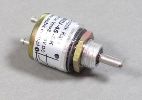
The non-contact angle sensor WMU45-SK has been developed for very precise measurements in the field of civil engineering, machine construction and industrial automation. Its use is recommended in applications requiring a low angle (90 degrees) and a high lifespan. The sensor contains a high resistivity magneto-resistive element Temperatures The lack of contact elements guarantees a long life, which can not be ensured by the contact element.
Technology and principle of operation
Strong and compact design allows use in all applications where space and sensor weight play an important role in controlling the position of the mobile robot arms. It is important to emphasize that the sensor realized in the magnetoresistance technology is completely passive. It acts as a voltage divider (potentiometer) composed of two resistors connected in series. Unlike conventional potentiometers and resistors, they are made of InSb alloy (indium and antimony) using a suitable technique on a ceramic substrate. At the same time, in contrast to the potentiometer, there is no movable slider, respectively, the change of the input voltage division causes contactless movement of the magnet over the magnetoresistor.
Dimensions, operating temperature and lifetime
The sensor has a metal housing with a diameter of 16mm and an axis with a diameter of 3mm embedded in ball bearings. The sensor body can be fastened with a screw nut thread M9x0.75, similar to a potentiometer. The sensor can work in a wide temperature range from -20oC to + 125oC. Due to the small diameter of the sensor and a huge service life exceeding 500 million cycles, the sensor is perfect for applications requiring long-term trouble-free operation that can be achieved by more expensive and more complicated optoelectronic transducers.
Applications
The magnetoresistive angle sensor is well-suited for tracing the rolls of paper or other materials produced or printed from a roll at high speed. An advantage here is also the incomplete rotation angle and a very linear characteristic in the area of zero position. The lack of complicated electronics is also the usefulness of the sensor applicator. Due to the good resistance to vibrations and impacts, the sensor can be used in difficult applications with a better result than special potentiometers, eg in road machines and self-propelled robots.
